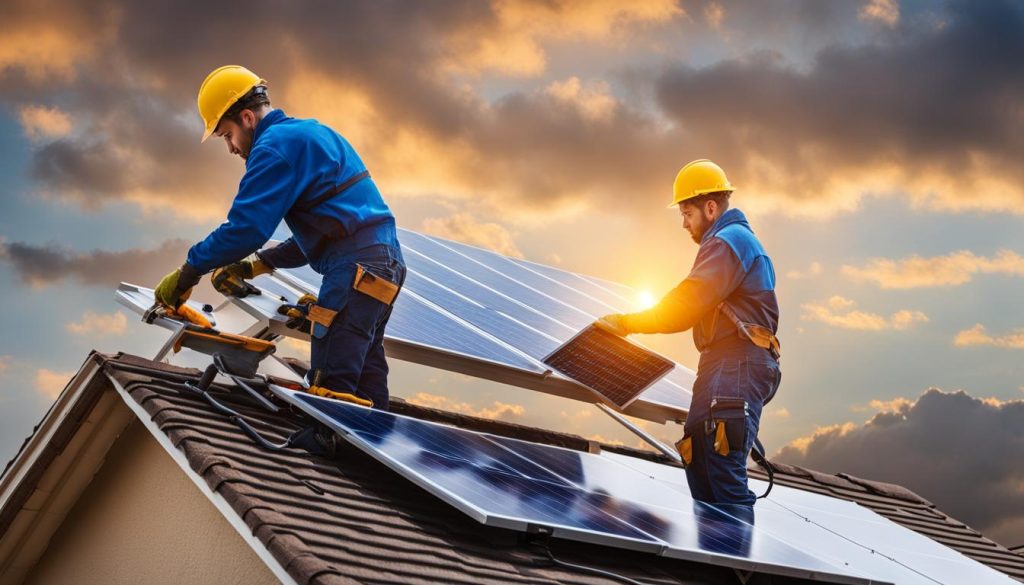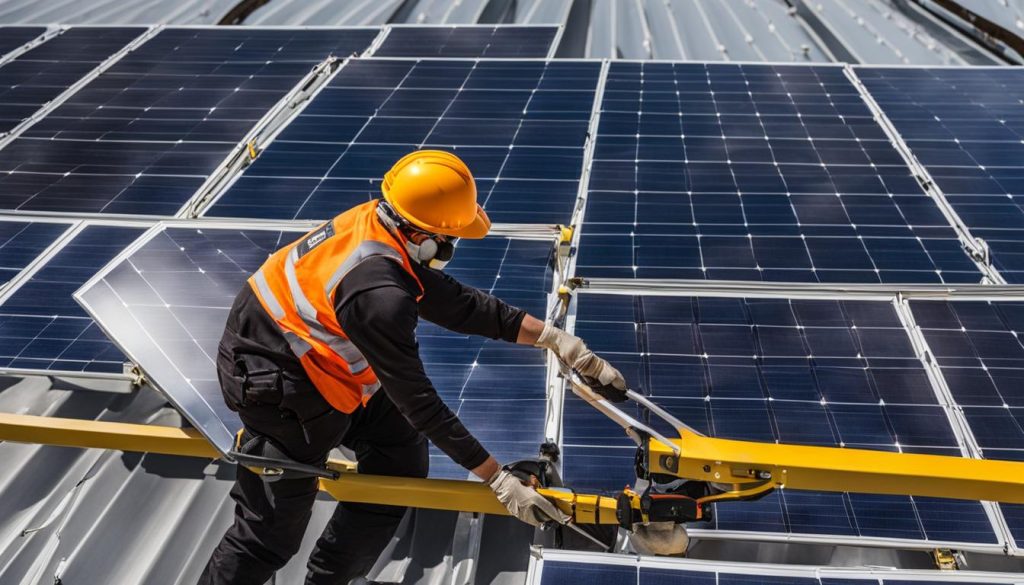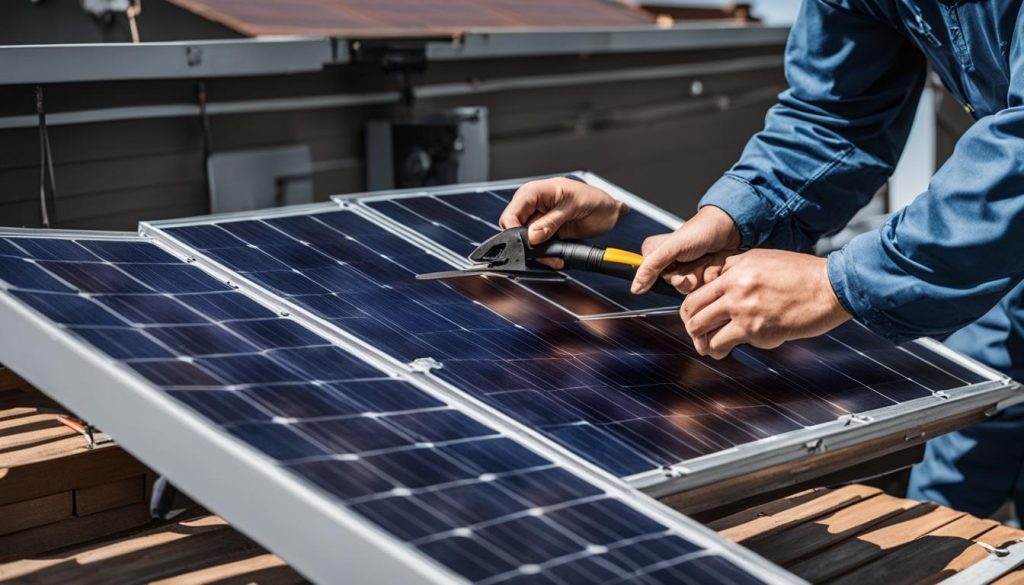To safely remove solar panels, it is important to have the necessary tools, technical knowledge of electrical components, and the ability to reach the installation area. Removing solar panels requires a step-by-step process to ensure no damage or harm occurs. The process includes shutting down the power, unplugging the solar panels, removing the panels from the roof, separating the hardware, unfastening cables and wires, removing the grounding system, and properly settling the components. Following these steps will ensure a safe and efficient removal of solar panels.
Key Takeaways:
- Removing solar panels safely requires the right tools and technical knowledge.
- The process involves shutting down the power, unplugging the panels, and removing them from the roof.
- Separating the hardware, unfastening cables and wires, and removing the grounding system are important steps.
- Properly settling the components in a dry and shaded place is crucial.
- Ensuring safety precautions and following guidelines is essential during the removal process.
Why Choose DIY Method for Solar Panel Removal
While it may be more convenient to seek expert assistance or consult an electrician for solar panel removal, choosing the DIY method can save homeowners a significant amount of money. However, it is important to note that removing solar panels is a technical process that requires caution and proper knowledge. DIY solar panel removal should only be attempted if the individual has the necessary tools, understanding of electrical components, and is willing to accept any potential loss or mishandling of expensive parts.
One of the main reasons to consider DIY solar panel removal is cost-effectiveness. Hiring professionals can be expensive, with fees varying depending on the complexity of the removal process and the location of the solar panels. By opting for the DIY method, homeowners can save on labor costs and have more control over the removal timeline.
Another advantage of DIY solar panel removal is the ability to learn and understand the system better. By taking on the task themselves, homeowners can gain valuable knowledge about their solar panel installation, its components, and how it operates. This knowledge can be beneficial for future maintenance or troubleshooting.
“By opting for the DIY method, homeowners can save on labor costs and have more control over the removal timeline.”
However, it is essential to recognize the risks associated with DIY solar panel removal. Mishandling the panels or incorrectly disconnecting electrical components can lead to damage or even electrical hazards. Therefore, it is crucial for individuals attempting the DIY method to thoroughly research and understand the removal process, follow safety precautions, and consult professional assistance if they encounter any challenges or uncertainties.

Benefits of DIY Solar Panel Removal:
- Cost-effectiveness by eliminating labor expenses
- Gaining knowledge about the solar panel system
- Having control over the removal timeline
In summary, while DIY solar panel removal can be a cost-effective option for homeowners, proper caution, knowledge, and safety precautions are crucial. By understanding the risks involved and being well-prepared, individuals can successfully remove their solar panels and potentially save a significant amount of money in the process.
Steps to Remove Solar Panels Safely
Removing solar panels safely requires a systematic approach to ensure the process is efficient and free from any potential hazards. By following these step-by-step instructions, homeowners can confidently remove their solar panels without causing damage or injury.
Gather the necessary tools and equipment
Before beginning the removal process, it is essential to have the right tools and equipment. This includes insulated gloves, safety glasses, a ladder or scaffolding, wrenches, and screwdrivers. Additionally, make sure to have a safe place to store the panels after removal, such as a dry and shaded area.
Shut down the power
The first step in safely removing solar panels is to shut down the power. Locate the disconnect switch or circuit breakers that control the panels and turn them off. This will ensure that no electricity is flowing through the system and reduce the risk of electrical shock during the removal process.
Unplug and remove the panels
Once the power is shut down, carefully unplug the solar panels from each other using insulated gloves. Take precautionary measures when working on difficult or sloped areas, ensuring stability and balance. Next, remove the panels from the roof mounting equipment by unbolting them. Gently lower the panels to the ground, avoiding any impact or damage.
Disconnect the hardware and grounding system
After the panels are safely on the ground, it’s time to disconnect the mounting hardware and electrical cables. Unscrew any nuts or bolts that secure the panels to the mounting equipment, and carefully detach the cables and wires. Finally, disconnect the grounding system to ensure no electrical current is present.
Properly settle the components
Once all the components are disconnected, settle them in a dry and shaded place. Use appropriate packaging materials to protect the panels and prevent any potential damage during storage or transport. It is crucial to handle the panels with care, as they can be fragile and expensive to replace.
| Steps to Remove Solar Panels Safely |
|---|
| Gather the necessary tools and equipment |
| Shut down the power |
| Unplug and remove the panels |
| Disconnect the hardware and grounding system |
| Properly settle the components |
Importance of Safety Precautions and Rapid Shutdown Systems
When it comes to removing solar panels, safety precautions are of utmost importance. This task involves dealing with electrical components and heights, which can pose risks if not approached carefully. Therefore, it is crucial to take the necessary precautions to ensure the safety of yourself and others involved in the process.

Firstly, always wear proper safety gear, such as gloves, goggles, and a hard hat, to protect yourself from any potential hazards. These protective measures can significantly reduce the risk of injury during the removal process. Additionally, it is essential to choose the right time of day to work on removing solar panels. Ideally, you should avoid working during adverse weather conditions, such as strong winds or rain, as they can make the task more dangerous.
“Safety must be the top priority when removing solar panels. Taking the right precautions and following proper procedures can prevent accidents and ensure a smooth and secure removal process.” – John Smith, Solar Panel Expert
Furthermore, it is crucial to ensure that there are no electrical loads connected to the solar panels before starting the removal. This step prevents any potential electrical shocks or accidents during the process. It is recommended to consult a licensed electrician to help with disconnecting the panels from the electrical system safely.
Importance of Rapid Shutdown Systems
In addition to safety precautions, the installation of Rapid Shutdown (RSD) systems for PV systems on buildings is mandated by the National Electric Code (NEC). These systems ensure that conductors are de-energized and below a certain voltage within 10 seconds of activation. Rapid Shutdown systems serve as an additional layer of safety, providing protection for both users and first responders during emergencies.
| Rapid Shutdown System Benefits | Rapid Shutdown System Components |
|---|---|
|
|
By incorporating Rapid Shutdown systems into solar panel installations, the risk of electrical hazards is significantly reduced. These systems provide peace of mind to homeowners, knowing that their solar panels are equipped with an added layer of safety in case of emergencies or maintenance needs.
Conclusion
Removing solar panels safely is a process that requires careful planning and technical knowledge. While opting for a DIY solar panel removal can save you money, it is crucial to consider the risks involved. By following a step-by-step guide and taking the necessary safety precautions, you can ensure a successful and hassle-free removal.
It is important to have the right tools and equipment for the job, as well as a good understanding of electrical components. Taking safety precautions, such as wearing appropriate safety gear and choosing the right time of day, is essential to avoid accidents and injuries.
Whether you’re removing solar panels for maintenance, repairs, or relocation purposes, having the right knowledge and precautions in place will make the process much smoother. Always remember to weigh the risks and benefits before attempting a DIY removal, and if you’re unsure, it is best to consult an expert or electrician for assistance.
FAQ
What tools are needed to remove solar panels safely?
To remove solar panels safely, you will need tools such as insulating gloves, safety gear, wrenches, screwdrivers, and packaging materials for component settlement.
Is it necessary to have technical knowledge of electrical components?
Yes, having technical knowledge of electrical components is important to ensure the safe disconnection and removal of solar panels. This knowledge helps prevent damage and ensures proper handling of the electrical connections.
Can I remove solar panels from the roof by myself?
If you have the necessary tools, technical knowledge, and are willing to accept any potential loss, you can attempt DIY solar panel removal. However, it is recommended to seek expert assistance or consult an electrician for a safer and more efficient removal process.
What precautions should I take when removing solar panels?
It is crucial to wear proper safety gear, choose the right time of day, ensure there are no electrical loads connected to the panels, and follow the National Electric Code (NEC) requirements for Rapid Shutdown (RSD) systems installation to enhance safety during the removal process.
How should I properly settle the components after removing solar panels?
After removing solar panels, settle the components in a dry and shaded place with proper packaging materials to prevent damage during storage or transportation.
Can DIY solar panel removal save money?
Yes, DIY solar panel removal can save homeowners a significant amount of money. However, it is important to consider the risks involved and ensure you have the necessary tools, knowledge, and willingness to accept any potential mishandling or loss of expensive parts.

